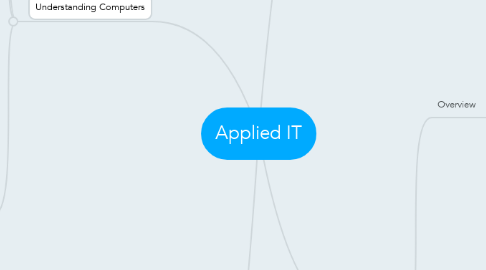
1. Understanding Computers
1.1. Hardware
1.1.1. Types
1.1.1.1. Tablet / Laptop / Netbook / desktop
1.1.1.2. Mainframe / Supercomputer /
1.1.2. Input Devices
1.1.2.1. Keyboard / Mouse / Microphone / Scanner / Digital Camera / Stylus
1.1.3. Output Devices
1.1.3.1. Monitors / Speakers / Printers
1.1.4. Processing
1.1.4.1. Motherboard / CPU / ROM / RAM / NIC
1.1.5. Storage
1.1.5.1. External Drive / Cloud Storage / Flash (USB) Storage
1.2. Software
1.2.1. Systems Software
1.2.1.1. Makes the hardware work
1.2.1.2. sits between the application & the HW
1.2.1.3. Windows / Apple System X / Linux
1.2.2. Application Software
1.2.2.1. Productivity Software
1.2.2.1.1. Word processing / presentation / calculations / database
1.2.2.2. Business Software
1.2.2.2.1. Accounting / Desktop publishing
1.2.2.3. Large Business Software
1.2.2.3.1. project management / ERP / CRM / CAD / ECommerce
1.2.3. Proprietary / Open Source
1.3. Networks
1.3.1. What is a network
1.3.2. Parts of a network
1.3.2.1. Sender / Receiver / Protocol
1.3.2.2. Server / Client / Peer
1.3.2.3. NIC
1.3.3. Types of Network
1.3.3.1. WAN / LAN
1.3.3.2. Internet
1.3.3.2.1. Naming System
1.3.3.2.2. Protocol
1.3.3.2.3. Internet / Extranet / Intranet
1.3.3.2.4. Disintermediation
1.3.3.2.5. Firewall
1.3.3.2.6. VPN
1.3.4. Transmission Media
1.3.4.1. Wireless
1.3.4.2. Cable
1.3.4.3. Bluetooth
1.3.5. Criteria to select nw
1.3.5.1. Cost
1.3.5.2. Performance
1.3.5.3. Other
2. ECommerce
2.1. Overview
2.1.1. Types of ECommerce
2.1.1.1. B2B / B2C / C2C / B2E
2.1.1.2. G2C / G2B / G2G
2.1.2. Internet / Extranet / Intranet
2.1.3. Purpose of ECommerce
2.2. Features of ECommerce
2.2.1. Disintermediation
2.2.2. Web2.0
2.2.3. Attracting & Retaining Customers
2.2.4. Online Payments
2.2.5. MCommerce
2.3. ECommerce Strategies
2.3.1. Bricks & Morter
2.3.2. Clicks & Bricks
2.3.3. Virtual Companies
3. Overview
3.1. What is IT
3.2. Data Vs Information
3.3. Model of Information System
3.3.1. Input of data
3.3.1.1. Qualitative
3.3.1.2. Quantitative
3.3.2. Processing
3.3.2.1. Classify
3.3.2.2. Rearrange / sort
3.3.2.3. Agregate
3.3.2.4. Calculating
3.3.3. Output of information
3.3.3.1. Tangible / Intangible Value
3.3.3.2. Qualities of information
3.4. Elements of Information system
3.4.1. People
3.4.2. Hardware
3.4.3. Software
3.4.4. Data
3.4.5. Communications / Network
3.5. Pro / Cons of Information Systems
3.5.1. Speed / Accuracy / Reliability / Repetitive tasks / programmable
3.5.2. No judgement / Less Flexible / Less Creative / No Intuition / Qualitative information
4. Security
4.1. Overview
4.1.1. Why do we care about security
4.1.2. How to respond to threats
4.1.3. Sources of threats
4.1.3.1. Unintentional Human
4.1.3.2. Malicious Human
4.1.3.3. Natural Events
4.1.4. Types of loss
4.1.4.1. Unauthorised data disclosure
4.1.4.2. Incorrect Data modification
4.1.4.3. Faulty Service
4.1.4.4. Denial of Service
4.1.4.5. Loss of Infrastructure
4.2. Elements of a security program
4.2.1. Hardware & Software - Technical Safeguards
4.2.1.1. Identification & Authentification
4.2.1.2. Encryption
4.2.1.3. Firewalls
4.2.1.4. Malware Protection
4.2.1.5. Secure Design
4.2.2. Data - Data Safeguards
4.2.2.1. Data Administration
4.2.2.2. Database Administration
4.2.2.3. Data Protection Laws
4.2.3. People & Process - Human Safeguards
4.2.3.1. Position Definition
4.2.3.2. Hiring & Screening
4.2.3.3. Dissemination & Enforcement
4.2.3.4. Termination

